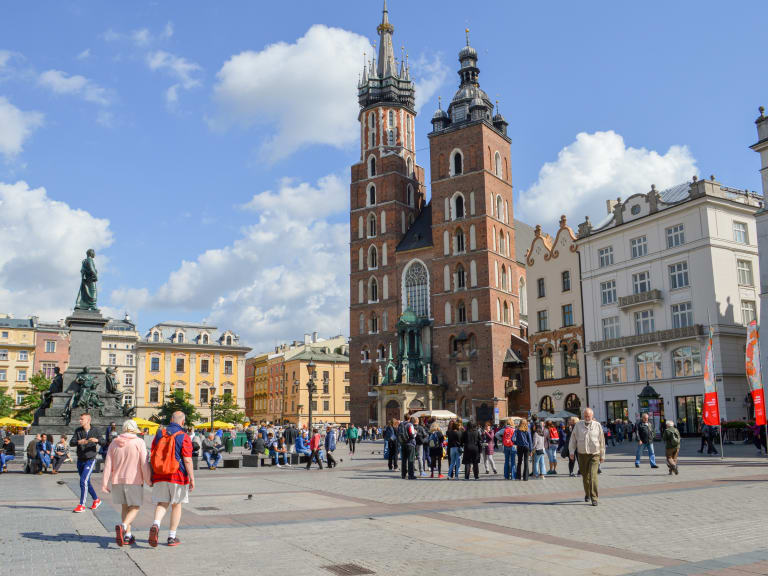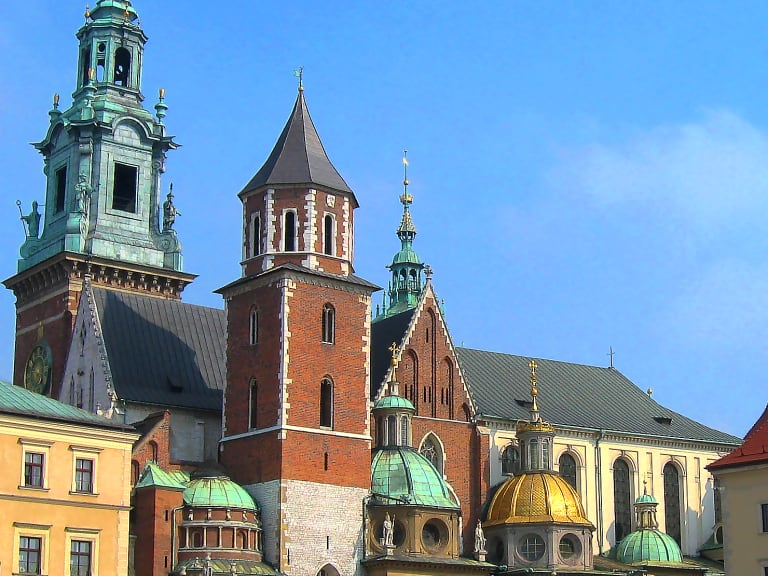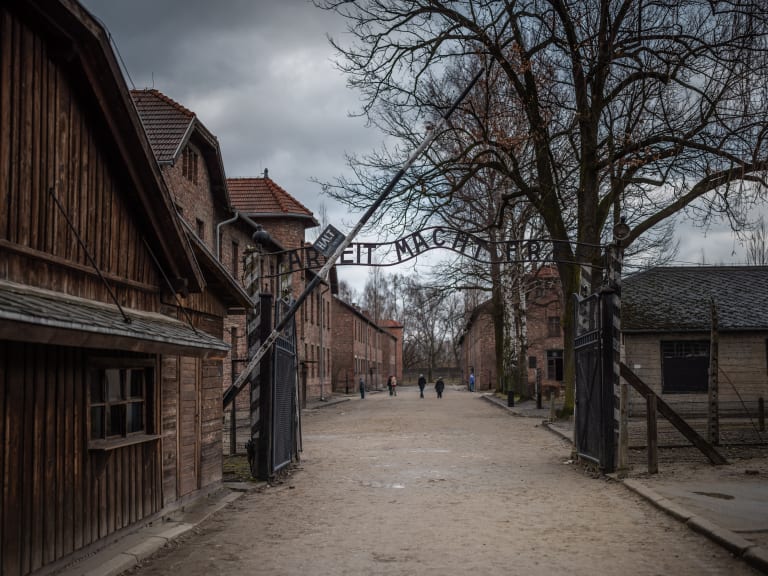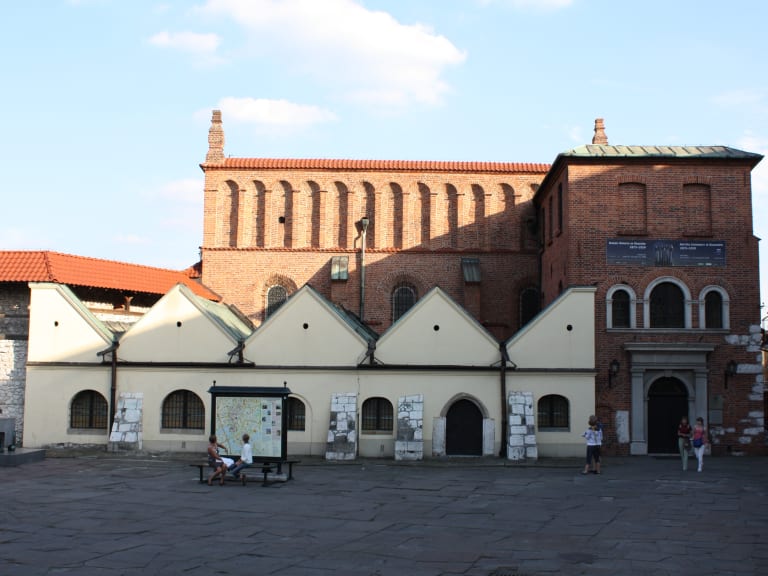More about: Things to Do in Krakow in 2 Days
A World Heritage-listed historic centre, a Jewish quarter with centuries of history and an increasingly lively atmosphere are just some of the many reasons to visit Kraków. Two days is the minimum time you should spend in the city to see most of its attractions.
Day 1: Get to know Stare Miasto, Krakow's medieval historic centre

The area of Kraków's medieval historic centre is undoubtedly the most visited by tourists. Inside the old walled city you will find many of the monuments, churches and buildings that are not to be missed, as well as a large number of shops and restaurants.
Its cobbled streets, lined with beautiful pastel-painted houses, are perfect for strolling through, and you will be surprised at every turn.
The best option for this tour is to book a guided tour, but you can also do it on your own.
Enter the historical centre through the Florian Gate and discover the Barbican and the city walls
To enter the Stare Miasto, head in front of Matejko Square, where an equestrian statue of Wladyslaw II, one of the kings of Poland, stands. The ensemble is known as the Grunwald Monument.
For centuries the old town was enclosed by walls, of which only a few hundred metres remain. The entrance to the town was the Florian Gate, built in the 13th century. Today, it is the only remaining gate and is the perfect place to start your visit to the historic centre.
In the area, before going deeper into the medieval centre, you can also see the tower of the Cabinetmakers, the tower of the Carpenters and part of the old city wall.
Walk along Florianska Street

The next stop on the tour is Florianska Street, which leads from the Barbican (a late 15th century fortification that today hosts exhibitions) to the heart of the medieval city.
This street is not only the best known in Kraków, but is also famous throughout Poland, as every metre of the street is full of charm. Although it is now lined with shops, cafés and restaurants, these are located in old buildings to delight in:
- Matejko House, number 41 on the street. This house was the residence of a famous painter of the same name and today there is a museum with his works and some military objects and historical costumes that he collected himself.
- The Jama Michalika café, a meeting place for the city's artists and journalists in the 19th century. The interior is decorated in Art Nouveau style and is worth a look.
- The Pod Hotel Roza, with a 16th-century Renaissance portal, and other historic houses lining the street are other places to look out for as you stroll along.
Market Square, the heart of the Old Town

At the end of Florianska Street lies Kraków's Market Square, undoubtedly the most famous place in the whole of Kraków. The buildings on the square, both those you can visit and those you can't, are well worth a visit.
This square, which at Christmas in Krakow hosts a fabulous Christmas market and at Easter stalls selling handicrafts from various neighbouring countries, has a few attractions that are worth a closer look:
- St. Mary's Basilica: one of the most important churches in Krakow. You can climb its towers to enjoy the views.
- Cloth Exchange: this former marketplace houses two different museums and souvenir stalls.
- Old Town Hall Tower: built in the 16th century, you can climb up to the viewing platform it houses, although be prepared for narrow stairs of over 100 steps.
Joaquín's Traveller Tip:
Every hour a small door opens in one of the towers of the Basilica of Santa María and a trumpeter comes out of it and plays a short melody. If you're in the area, it's a fun time to spend in the square.
Grab a bite to eat in the area
This can be a good time to recharge your batteries. So that you don't have to stray too far from your route, I suggest you eat at one of these restaurants located near the square:
- Milkbar Tomasza: this place is a sort of a more modern version of the traditional Polish milk bars. The prices are very low and the service is very fast. Another advantage is that the menu is in English. It is located on Świętego Tomasza Street.
- Chlopskie Jadlo: although the price is high by Polish standards (about €15 per person), this traditional restaurant is worth the money, especially as it is located in the city centre. You can order anything from typical pierogis to zurek soup. It is located at 9 Grodzka Street.
Joaquín's Traveller Tip:
the lunch time in Poland is earlier than in Spain. Lunch is usually around 13:00, although in most places you won't have any problems if you arrive an hour later.
Follow in the footsteps of Copernicus at the Collegium Maius

Still within the historic centre is the Collegium Maius. The building, which has been renovated several times, was built in the 15th century and has seen such important figures as Nicolaus Copernicus pass through its halls.
The visit inside, which can only be guided, is really interesting. In its rooms you will be able to see a large number of objects related to almost all areas of knowledge: physics, chemistry, meteorology, cartography and, of course, astronomy.
The building's courtyard, with its fountain, is another must-see area. On one side there is an old clock that opens every two hours to reveal a number of wooden figures parading around while music plays.
Forget about time at Wawel Castle
The next stop on the tour is on top of a small hill. This is Wawel Castle, a 1000 year old fortification that housed the former seat of Polish royalty until the 17th century.
My recommendation is to book a guided tour of Wawel Castle to get to know in depth the rooms that can be visited there:
- Lost Wawel: an exhibition on the history of the hill located in the basement of the palace.
- State Rooms- several rooms with furniture, paintings, tapestries and other original objects from the palace.
- Royal Apartments: the rooms where the royal family resided.
- Treasury and Armoury: as the name suggests, here you can see jewellery, weapons and armour.
In addition to these interior visits, the castle also has an exterior garden that is well worth a leisurely stroll.
Don't miss the Wawel Cathedral

Still within the castle complex is the impressive cathedral dedicated to St. Stanislaus, which you can enter for free. However, if you want to get to know it in depth and learn about its history, you can do so by choosing the option of taking a guided tour of Wawel Castle which includes entry to the Cathedral.
Inside you can see the Sigismund Chapel, which does have an entrance fee, built in a beautiful Renaissance style and with a beautiful dome. You should also take a look at the Mausoleum of St. Stanislaus and the crypt in which several of the country's kings are buried.
If you wish, it is also interesting to climb the Sigismund Tower and see the impressive 16th century bell that was installed in the defensive towers of the complex.
Walk along Grodzka Street back to the Market Square.
Descending from the hill, look for the beginning of Grodzka Street, one of the busiest streets in the centre. In addition to shops and beautiful buildings, this street is home to the Church of St. Peter and St. Paul, one of the most beautiful in the whole country, especially for its exterior decoration. My advice is to walk along this street at your own pace and sometimes take a detour to its parallel, Kanonicza Street, to enjoy some Renaissance houses and other churches.
At the end of the day's tour you return to the Market Square. Stay there to see the night illumination and look for a place to have dinner.
If you still have some rhythm left in your body and want to enjoy the best atmosphere of the city, don't miss the pub crawl in Krakow. 5 hours of non-stop partying!
Day 2: Krakow's Jewish heritage, from the synagogues to the ghetto

Many tourists choose the morning of their second day to take a trip to Auschwitz or to visit the Wieliczka salt mines. However, there are still plenty of things to see in Kraków, especially if you want to get to know the city in depth, so the choice is yours.
In case you decide to finish seeing the city, I've booked the Jewish Quarter and the remains of the city's notorious ghetto for this second day.
Explore Kazimierz, the thriving Jewish Quarter
After a leisurely breakfast, the tour will start in this beautiful neighbourhood south of Wawel Castle. The area is within easy walking distance from the centre, but if your hotel is too far away or you simply don't feel like walking, you can always take a tram to the entrance of Kazimierz, Kraków's Jewish quarter.
Kazimierz was founded as an independent town in the 14th century, but was incorporated into Kraków as early as the 19th century. From its foundation until the Second World War it was the place of residence of the Jewish community. Today, the district is home to the second largest collection of Jewish monuments on the continent, second only to Prague.
To get to know the area well, you can take a tour of the Jewish quarter or wander through the streets and discover its beautiful corners. If you go on Sunday, don't miss the antiques market in Nowy square.
Enter the Old Synagogue to learn about Jewish culture in Krakow

A visit to the Old Synagogue on Szeroka Street, the oldest Hebrew temple in the country, is a must on your tour of the Jewish Quarter.
As well as looking at the exterior, it is also well worth going inside to see the Museum of Jewish Culture. Once you have paid the entrance fee, you will be able to witness the history of the Jewish community in Kraków thanks to the objects on display. You will learn about their culture, their way of dressing, their celebrations and, perhaps most shockingly, the persecution to which they were subjected by the Nazis.
Apart from the objects and photographs in the museum, the highlight of the interior of the temple is the prayer room, with an altar where the Torah was read and a niche in which the sacred texts were kept.
Discover the Remuh Synagogue Cemetery
Another synagogue in Kazimierz that you must visit is the Remuh Synagogue (also for a fee), built in the 16th century. Although it is the smallest in the neighbourhood, it is the only one that still retains its religious function.
Behind the main building is a very interesting cemetery. Unfortunately, some of the oldest graves were destroyed by the Germans and their remains used as paving stones for the streets.
Stroll through the quarter and see the Isaac's Synagogue and Tempel Synagogue
While strolling through the streets of the quarter, you can't miss two other synagogues. Although you can enter both, it may be enough to see them from the outside.
The first is Isaac's Synagogue, at number 18 Kupa Street. The building, of rather simple architecture, was built in the 17th century on behalf of a Jewish banker and merchant.
The other synagogue you should visit is the Tempel Synagogue, the last one built in Kazimierz at the end of the 19th century. The highlight of the temple is its stained glass windows.
Eat in the Jewish Quarter
While strolling through the quarter you will no doubt have noticed the large number of restaurants lining the streets. The ones next to the Old Synagogue are a bit more expensive, but they have a good range of kosher dishes, which you will find if you book a gastronomic tour of Krakow.
If you prefer something less touristy, there is no shortage of options in the neighbourhood, such as the simple Polakowski Restauracja (on Miodowa Street) or the Kuchnia Domowa Sąsiedzi (on the same street).
A visit to the Oscar Schindler's factory

To reach the next point on the itinerary, leave the Jewish Quarter and cross the Vistula River over the Powstańców Śląskich Bridge. Then look for Lipowa Street, where you will find what is known as Schindler's Factory.
Schindler was a German businessman who managed to save the lives of more than 1000 Jews by using his kitchen equipment factory. Today, the factory is the site of the permanent exhibition "Krakow under Nazi occupation".
A tour of the Schindler factory will give you an insight into the history of the city during the Second World War, as well as some of the objects used in the making of the film that made the factory world famous.
Remnants of horror in Podgórze, the Jewish ghetto
Surrounding the Schindler Factory is what remains of one of the most horrific places that existed in Kraków during the Second World War: the Jewish ghetto. The Nazis sent more than 15,000 people there to, in their words, 'cleanse the city of Jews'. To isolate them, they built a wall around the 30 streets where the deportees lived in overcrowded conditions.
Podgórze, the name of the neighbourhood that housed the ghetto, has its centre in Bohaterów Square. A monument of 60 chairs has been erected there to commemorate the Jews who were moved to the area.
On Lwowska Street and Limanowskiego Street you can see the few remains of the wall that once surrounded the Jewish ghetto.
Enter a hero's shop: the Eagle's Pharmacy
On a corner of Bohaterów Square stands the Eagle's Pharmacy (Apteka pod Orlem), known for its owner's resistance to leaving when the ghetto was built.
Unlike other shopkeepers in the area, the pharmacist preferred to remain there and it is believed that he helped to save several of the Jews who were moved there. Today, an exhibition on Nazi atrocities can be seen inside the ghetto.
Don't miss the façade of St. Joseph's Catholic Church
Continuing along the riverbank itself, I recommend that you walk along the streets leading from the former ghetto until you find St. Joseph's Catholic Church. Although its interior is quite simple, you should not miss the chance to admire its splendid façade.
From here you have to continue walking towards the river until you cross it again, this time over the Marshal Józef Piłsudski Bridge.
Another highly recommended option is to get on the Krakow tourist bus to finish your day of sightseeing by visiting the most interesting corners of the city and perhaps discovering new ones that will make you want to return.
Dinner at Plac Nowy

To finish the itinerary you have to walk back into Kazimierz until you reach the New Square, Plac Nowy in Polish. There you will see a circular building in the centre which was built to house a slaughterhouse. Today it is full of small kiosks selling food, especially zapiekanka, a kind of baguette with mushrooms and other ingredients.
Around the square there are also other stalls offering everything from grilled meats to homemade sausages. There is no better place to dine than here, either on one of the few chairs in the area or on one of the benches in the square.



